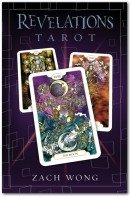|
Tarot Reflections |
August 2005 |
| Review: Revelations Tarot Sandra Thomson, CTGM |
|||||||
|
When each Major Arcana card is reversed, a different masked figure and design appears. This was somewhat disconcerting to me at first, as I pondered whether to respond to the entire card illustration or only to the half that was upright. I finally realized that viewing the card in its entirety forces me to keep alive the polarities that pertain to any given card. So, while the upright card speaks of what's actively operating within me today - or at least is more obvious - the double illustration reminds me that, at the same time, the reverse or polarity also remains potentially active in my life - at the flip of a card, doncha know. That makes this a deck to spend a lifetime with, probing for the unrealized.
Frankly, I find many of his meanings for upright cards not that different, i.e., The Fool symbolizes "the free spirit within," while The High Priestess represents "the voice inside us that calls us to heed our intuition." It is in his reversed definitions where I think Wong's writing is most interesting, creative, and even poetic at times. For instance, the reverse of The Empress suggests "someone lost in the wilderness of his or her own self. . . .Projects are started in vain, canvases remain blank, and the home feels more like a hollow vessel that is barely warm." The reverse of The Hierophant represents someone "who would be viewed as eccentric and unorthodox." Reading Wong's reversed meanings may help you understand reversed meanings for your other decks as well. The final chapter on spreads contains four ho-hum spreads: Past, Present, Future; Four elements; Seven Days; and The Horoscope Spread. The suggested questions to apply are mostly of a fortune-telling type: "What should I do about my current job?" "What will become of my investments in my neighbor's joint venture?" Here is where Zach Wong could definitely use some help, as well as Llewellyn for condoning such shallowness. The book-deck set (ISBN 0-7387-0607-8) is a publication of Llewellyn Worldwide and is available in bookstores. |
||||||
|
|
|||||||
|
Subscribe to Tarot Reflections, and receive notification of each update! |
|
Request to be added to the list by sending email to TarotReflections-subscribe@yahoogroups.com! |
All articles remain the
property of their respective authors.
Tarot Reflections is a publication of the American Tarot Association
- Copyright (C) 2005
Questions or Comments? Contact Us.



 Wong's companion book contains a description of the characteristics of both the upright and the reversed figure of the Major Arcana, plus an explanation of some of the images and symbolism. The same sections apply to the Minor Arcana cards, but here the "characters" themselves are not defined. Rather, Wong mostly gives a meaning for the card.
Wong's companion book contains a description of the characteristics of both the upright and the reversed figure of the Major Arcana, plus an explanation of some of the images and symbolism. The same sections apply to the Minor Arcana cards, but here the "characters" themselves are not defined. Rather, Wong mostly gives a meaning for the card.